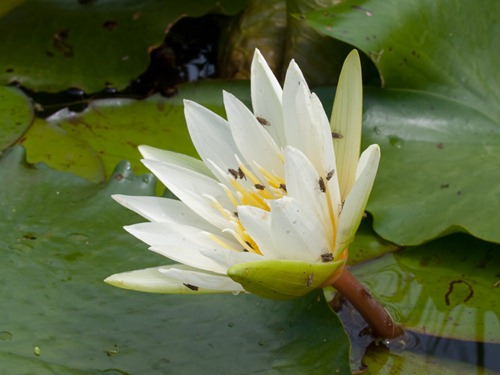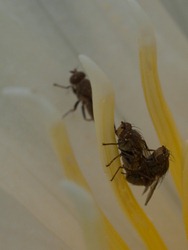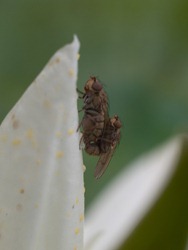One of two species of floating aquatic ferns at Palo Verde, the leaves of S. minima are extremely small and are covered with dividing setae.
Now, who knows the family of the bug surveying the Salvinia?
I think this is the same species that stung me in the lip. They construct a ball-like hive and the individuals are of similar appearance. In the photograph below, one of the workers is about to place another ‘brick’.
One of my first and most popular posts is the Collembolan orgy. I get hits from it nearly every day… you know, people searching for the word ‘orgy’. Well, with a second post entitled so, Google will hopefully up Montegraphia’s rank for the keyword… I’ll get even more curious folks.
Anyway, I collected a few of these guys for Dr. Foote. They seem to be everywhere in the wetland, but something about this Nymphea flower caused them to react a bit differently. Are they pollen eaters?
Another thing; How do I sweep for flies in a wetland? When the net gets wet, it is extremely difficult to pull flies out into the kill jar.
 |
|
 |
 |
As I mentioned before, the Thalia is quite tall. On the way to the fence, it peaks around 3 m high in waist deep water. In other areas, there are points where the Thalia approaches 4 m and is incredible difficult to pass through.
Again, much of the Thalia has been consumed by a moth larva (the moths themselves emerge around dusk and fly across the wetland by the millions!). What is left by the larva are stems and razor sharp, pointed ‘leaves’. Essentially, all that remains of the leaves is the center, supporting vein. Whole leaves look similar to banana leaves. It’s interesting that this defoliation is occurring at flower/seed set for the plants. As Mark pointed out, what implications does this have for the recruitment? I haven’t encountered any untouched plants, but it would be interesting to see if seeds are more numerous or weigh more (or something along those ‘fecundity’ lines). The plant is perennial too, and I wonder if the herbivory influences underground energy storage and likelihood that an individual will survive to the next season.